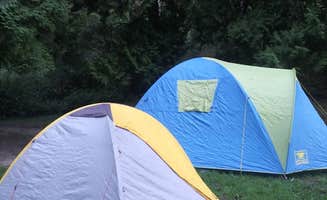Wayne National Forest provides rustic camping near Barboursville, West Virginia, with limited infrastructure throughout its fragmented public lands. Spanning over 244,000 acres across southeastern Ohio, the forest features elevations between 650 and 1250 feet. Winter temperatures regularly drop below freezing from December through February, while summer brings hot, humid conditions with frequent thunderstorms.
What to do
Fishing opportunities: Several small lakes within Wayne National Forest offer fishing for bass, bluegill, and catfish. At Timbre Ridge Lake, visitors can enjoy a serene fishing experience on the 100-acre lake with boat access limited to non-motorized craft.
Wildlife watching: Spring and early summer provide optimal wildlife viewing conditions. "We hiked here today to retrieve some trail cameras from the surrounding Wayne National Forest for a spotted skunk study at Ohio University. Along and just off the trails were tons of gorgeous wildflowers like trilliums, violets, showy orchids, and more!" noted one visitor to Hanging Rock Recreation Site.
ATV riding: The forest contains extensive trail systems for off-highway vehicles with specific width requirements. "The Hanging Rock Recreation area features tons of well kept ATV trails for motor bikes or quads (max width allowed is 50 inches)," reports a camper who explored the trail system.
What campers like
Solitude: Some dispersed sites offer remarkable privacy despite proximity to populated areas. "The good was I found a spot quickly and had 2 entire ponds to myself," reported a visitor at Hanging Rock Recreation Site.
Natural light displays: Summer evenings in the forest provide unexpected natural phenomena. "We stayed in the parking lot as it was getting dark and didn't know if there were any place to turn our rv around. Very quiet night and were visited by fireflies which was awesome," wrote a camper at Hanging Rock Recreation Area.
Lake views: The forest contains several small lakes with scenic camping opportunities nearby. "It is a very pretty area along Vesuvius Lake with trees and bluffs," noted a camper at Sand Hill Trailhead.
What you should know
Navigation challenges: The interspersed private and public lands create navigation difficulties. "We arrived late at night wishing we had better cell reception and a paper map of the National Forest. We were grateful to have the Dyrt's info downloaded on my chromebook," explained a camper at Sand Hill Trailhead.
Limited facilities: Most dispersed camping areas provide minimal or no amenities. While some recreation areas offer basic toilets, most sites lack services including trash removal.
Local activity: Some camping areas experience periodic local traffic that may disrupt tranquility. "The bad was locals firing guns for the hell of it for an hour straight and the trash left behind from the previous campers," reported a visitor, though they noted, "Once night fall hit everything was quiet."
Tips for camping with families
Safety concerns: Some areas may present safety hazards requiring additional supervision. "Not the greatest place to camp. Trash in most places, people partying all the time. Watch for needles if you go! Be sure to wear shoes," cautions a visitor to Hanging Rock Recreation Site.
Nighttime considerations: The remote forest setting can create an intimidating atmosphere after dark for some families. "Me and my family were here for 2 days and everything about it especially at night it's really scary would not recommend," shared one family camper.
Alternative camping options: For families seeking more amenities, investigate established campgrounds rather than dispersed sites. Wayne National Forest contains several developed campgrounds with standard facilities that may better accommodate family needs.
Tips from RVers
Parking limitations: RVs face significant constraints at most dispersed sites. "We stayed in the parking lot as it was getting dark and didn't know if there were any place to turn our rv around," reported an RVer describing the tight spaces and limited turnaround areas.
Overnight alternatives: When dedicated camping areas prove unsuitable, some parking areas can serve as overnight stops. "Better than Walmart" noted an RV camper who used a recreation area parking lot as an impromptu overnight location.
Size restrictions: Most forest roads and camping areas cannot accommodate large rigs. Small to medium RVs under 25 feet have better success finding suitable parking spaces at trailheads and recreation areas.


